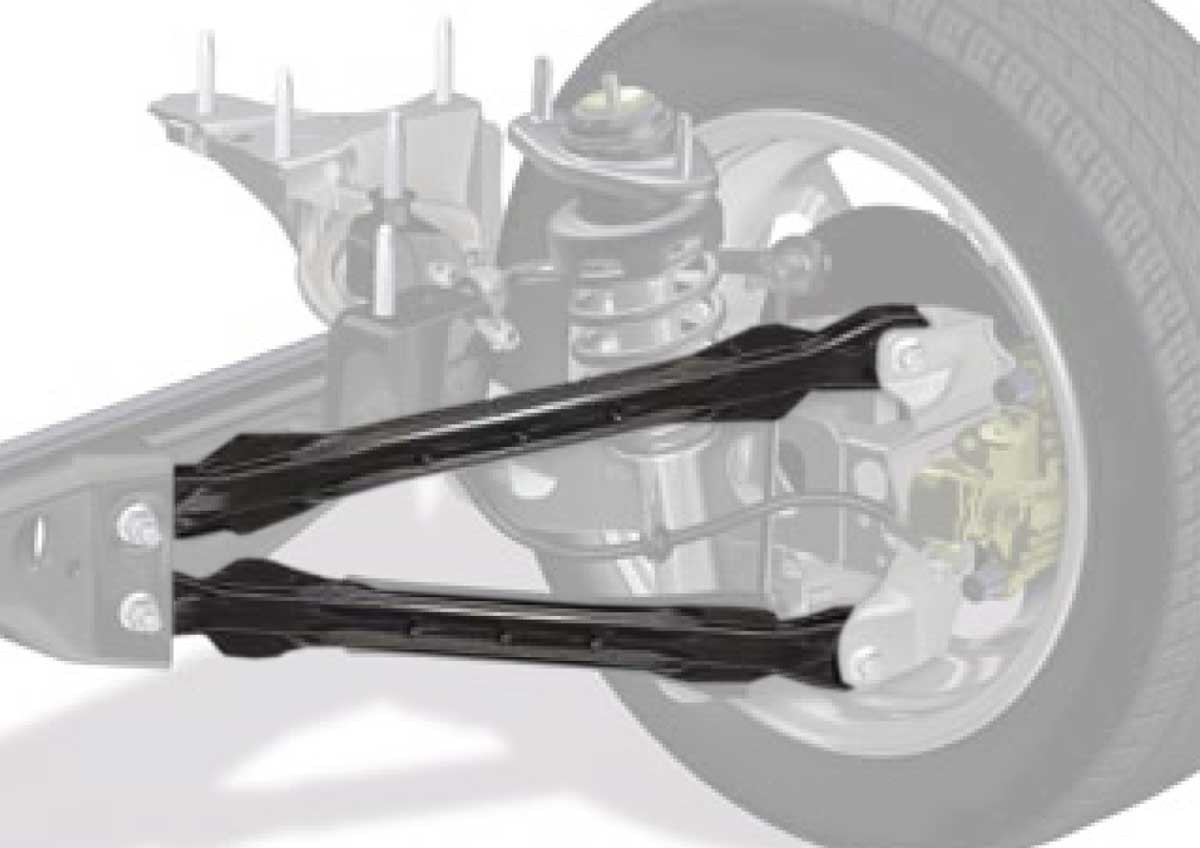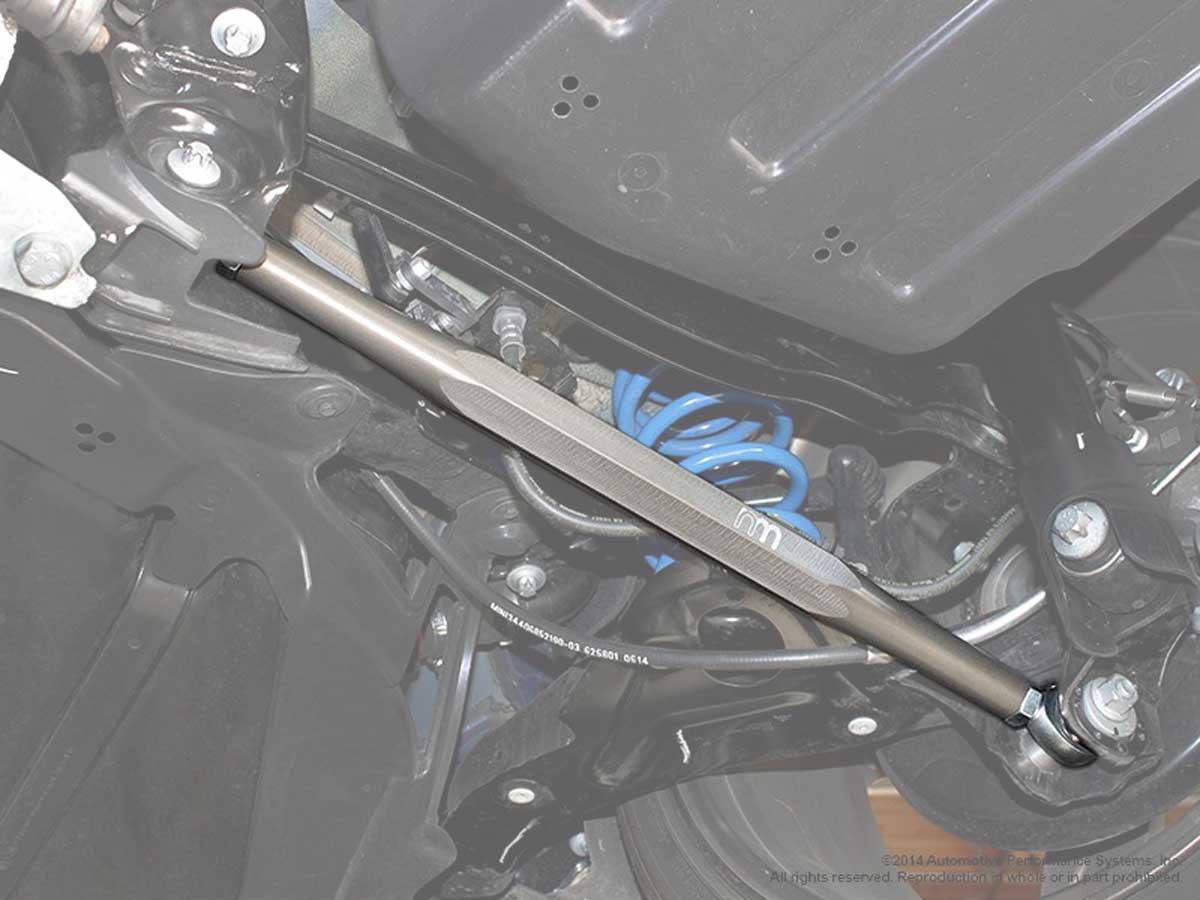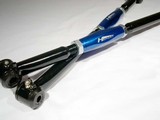Mini Cooper Adjustable Rear Control Arms Application Guide

Read below to see why Adjustable Rear Control Arms are essential for:
- Minis with Lowering Springs
- Minis with Coilover Suspension upgrades
- Minis driven at track events
Read below to learn about Rear Control Arms, or scroll down to see the Adjustable Rear Control Arm Application Guide.
See our Mini Cooper Performance Parts, an Upgrade Guide for your Mini for other upgrade options.
Mini Cooper Rear Control Arms - What are they?
The Rear Control Arms on the Mini Cooper are critical components of the rear suspension that help maintain optimal suspension geometry as the suspension reacts to the varying road surfaces. The Mini Cooper has 'fixed length' upper and lower control arms on each side of the rear axle. The length of these control arms determine the camber and toe settings. As long as the suspension or chassis is not damaged or bent, the stock control arms should set the rear camber and toe to the factory specifications.
Camber is the amount of deviation from vertical. Negative camber means the tops of the tires are tilted into the fender. This helps to keep more of the tire in contact with the road in turns (improves grip in the turns) but can also accelerate tire wear when the camber is excessive.
Toe is the amount of deviation from the forward direction. 'Toe-in' means the fronts of the tires are pointed towards the center of the car (think pigeon toe'd) and 'toe-out' means the fronts of the tires are pointed away from the center of the car. Changing the toe in the front and rear can make the car 'turn' more easily but also makes the car more sensitive and can make the car wander more when going straight. This can also accelerate tire wear when the toe is out-of-spec.
On some newer models, a set of concentric mounting bolts on the outboard ends of the rear lower control arms are used. These concentric bolts allow a small degree of camber adjustment, but they are limited to a fraction of a degree range of adjustment.
All of the 1st generation and 2nd generation Mini Cooper models share the same rear control arms. The 3rd generation F-series Mini Cooper models have a slightly different rear suspension where the control arms are different. The upper control arms on the 3rd generation models have a slight bend in them to clear other suspension components.
The camber and toe is set by the factory for maximum safety, driveability, and tire life while maintaining the 'sporting' handling of the Mini. We recommend you keep the stock settings, unless you drive your Mini on the track. Your Mini can be made to handle better on the track by modifying the camber and toe beyond specifications, but you sacrifice some safety, driveability and tire life in exchange for lower lap times. It's all a trade-off.
Mini Cooper Adjustable Rear Control Arms - Why you need them
When the Mini Cooper is lowered using lowering springs or coilover shocks to improve handling or looks, the lower ride height causes a large increase in negative rear camber - the lower the car, the greater the negative camber. This causes a change in suspension geometry which affects the handling. The negative camber also causes uneven tire wear (the inboard side of the rear tires will wear faster than the out board side) leading to greatly reduced tire life.
Even without lowering the ride height, the adjustable rear control arms will allow modifying the rear camber and toe to manipulate the handling characteristics for track applications.
The front suspension uses MacPherson Struts where the camber, toe, or caster is not affected by lowering.
The addition of the Adjustable Rear Control Arm provides the capability to correct this negative camber on cars with lowered ride height. By varying the length of the Rear Control Arms, the camber and toe of the rear wheel can be adjusted.
The factory specification for the rear camber ranges from -1.5 degrees to -2.0 degrees depending on the models. Lowering the Mini can increase this camber to -3.0 degrees and more!
Most Mini owners with lowered Minis simply replace the two lower control arms with adjustable units which allows the rear camber to be corrected back to factory specifications, but this also has a slight affect on the rear toe setting. For most street application, the change in toe is small enough to be inconsequential.
For those Mini owners that drive on the track and need to 'dial in' the suspension for maximum improvement in handling, the best approach is to replace all 4 control arms with adjustable units. This allows independent adjustment of rear camber and rear toe.
On models with the factory Xenon headlight option, there is a 'level sensor' attached to the rear left upper control arm. If you choose to replace all 4 rear control arms with adjustable units, you will need to fabricate a mounting for the level sensor since none of the adjustable arms have accommodations for the sensor. Most customers simply use a pair of hose clamps to secure the sensor to the adjustable arm.
An alignment will be necessary to adjust the rear camber back to factory specifications. Before you install the adjustable arms, we recommend that you adjust the length to match the stock arms. Then drive your Mini to the nearest alignment shop to correct the camber.
To summarize, the Adjustable Rear Control Arms are essential for lowered Minis, Minis with Coilover upgrades, and track driven Minis because these arms will:
- Correct rear negative camber and preserve stock driveability
- Help reduce tire wear
- Improve handling and lap times on track driven Minis
Mini Cooper Adjustable Rear Control Arm - What to look for
Customers frequently ask 'which control arms should I get?'. Several manufacturers offer adjustable arms and they all have some features that differentiate them. Below are some of the features to look for:
Rod Ends - The end of the Adjustable Control Arms can have either a 'Fixed Bushing' or Heim Joints.
- Fixed Bushing ends offer a smoother and quieter ride for street driven Minis. This is due to the bushing providing some 'flex' to absorb some of the vibration. The drawback is the 'flex' with the bushing - which is not as precise as a solid Heim Joint.
- Heim Joint ends are more expensive and offer a more precise and 'tighter' connection the chassis. The benefit is more precise handling and the drawback is noise. Since there are no bushings to absorb the vibration, the vibrations from the road surface is transmitted into the chassis. Heim Joints can also allow some rotation of the arms, just by the nature of the design. This 'can' cause some clunking noise when going over bumps. Some of the adjustable arms have an optional rubber boots to cover the Heim Joints which provides protection from dirt and grime that may cause performance noise.
Arm material - Adjustable arms can be made of alloy material for light weight or steel for strength.
Lubrication - When the Adjustable Arms are first installed, the ends are lubricated with special grease to allow for smooth motion. Over time, this lubrication may dry out and the arms may start to make noise, especially in cold weather. For this reason, some arms come with a zerk fitting to simplify adding grease. On arms without the zerk fitting, you may need to remove the mounting bolts to lubricate the joints (fairly simple job). This should only be necessary every couple years or so (depending on climate).
Adjustment design - In order to adjust the length of the adjustable arms, the center portion of the arm is rotated against the ends. If the arms are round, it would be difficult to attach a wrench. For this reason, the arms are are not always 'round', or they have machined 'flat areas' where the wrench can grip the arm during adjustment. Some arms are easier to adjust than others. Keep in mind that most often, once you adjust the length of the arms during the initial alignment, you will most likely not have to adjust them again.
Cost - Obviously, the price of the Adjustable Control Arms will vary from one manufacturer to the next depending on the features and materials. You will need to weigh the features compared to the cost and your budget.
All of the Rear Adjustable Control Arms are functionally very similar - they all allow you to adjust the rear camber. Some are higher quality than others, and some have different features. The decision on which arm to select depends on your application, which features you need or want, and your budget.
MINI COOPER ADJUSTABLE REAR CONTROL ARMS APPLICATION GUIDE
| Body | Year | Mini Mania | Eibach | H-Sport | Ireland Engineering |
NM Engineering | Forge Motorsports |
| Hardtop R50 & R53 | 2002-2006 | NMS5015 | G2NMS2200 | G2NMS2210 | G2NMS2215 | G2NMS2111 | |
| Convertible R52 | 2005-2008 | ||||||
| Hardtop R56 | 2007-2013 | NMS5015 | G2NMS2200 | G2NMS2210 | G2NMS2215 | G2NMS2111 | |
| Clubman R55 | 2008-2014 | ||||||
| Convertible R57 | 2009-2015 | ||||||
| Coupe R58 | 2012-2015 | ||||||
| Roadster R59 | 2012-2015 | ||||||
| Countryman R60 | 2011-2016 | NMS5015 | G2NMS2200 | G2NMS2210 | G2NMS2215 | G2NMS2111 | |
| Paceman R61 | 2013-2016 | ||||||
| Hardtop F56 | 2014+ | G3NMS2111 | G3NMS2120 | ||||
| Hardtop F55 4-Door | 2015+ | ||||||
| Clubman F54 | 2016+ | ||||||
| Convertible F57 | 2016+ | ||||||









